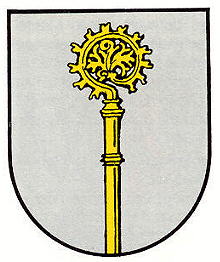Weidenthal: Difference between revisions
Jump to navigation
Jump to search
Knorrepoes (talk | contribs) m (Text replace - "|width="15%"|50 px|right |}" to "|width="15%"|50 px|right |}<seo title="Wappen, Gemeindewappen" />") |
Knorrepoes (talk | contribs) m (Text replace - "[[Literature" to "{{media}} [[Literature") |
||
| Line 18: | Line 18: | ||
The arms are based on the seal of the village, dating from 1747 and 1762, that showed a crosier. The crosier is the symbol of the Bishop of Speyer, to whom the village belonged from medieval times until 1803. The 18<sup>th</sup> century seals also showed the letters W and D (Weiden Dal), but these were removed on later seals and not added to the arms. | The arms are based on the seal of the village, dating from 1747 and 1762, that showed a crosier. The crosier is the symbol of the Bishop of Speyer, to whom the village belonged from medieval times until 1803. The 18<sup>th</sup> century seals also showed the letters W and D (Weiden Dal), but these were removed on later seals and not added to the arms. | ||
{{media}} | |||
[[Literature]] : Debus, 1988 | [[Literature]] : Debus, 1988 | ||
Revision as of 08:52, 9 July 2014
| Heraldry of the World Civic heraldry of Germany - Deutsche Wappen (Gemeindewappen/Kreiswappen) |
WEIDENTHAL
State : Rheinland-Pfalz
District (Kreis) : Bad Dürkheim
Verbandsgemeinde : Verbandsgemeinde Lambrecht
Origin/meaning
The arms were granted on May 15, 1845.
The arms are based on the seal of the village, dating from 1747 and 1762, that showed a crosier. The crosier is the symbol of the Bishop of Speyer, to whom the village belonged from medieval times until 1803. The 18th century seals also showed the letters W and D (Weiden Dal), but these were removed on later seals and not added to the arms.
Contact and Support
Partners:
Your logo here ?
Contact us
© since 1995, Heraldry of the World, Ralf Hartemink 
Index of the site
Literature : Debus, 1988











